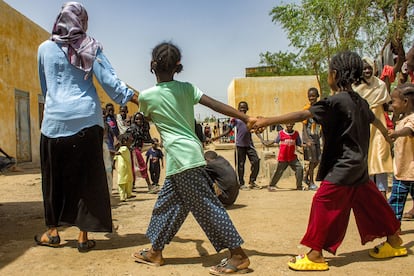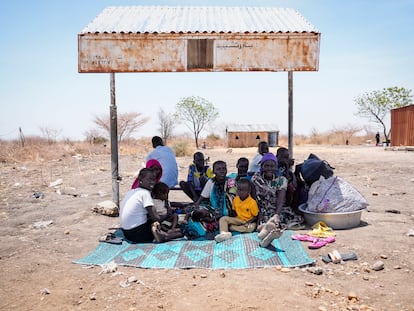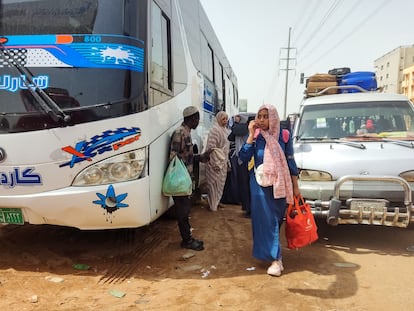The global struggle against mycetoma is paralyzed by the conflict in Sudan
The Mycetoma Research Center in Khartoum, the only institution that specializes in this forgotten disease, has suspended its activities. Thousands of patients now lack treatment

It is 2001, and Mohammed Safi Ahmed El-Safi is in the midst of his wedding preparations. As henna is applied to his feet — in Sudanese culture, men are permitted to wear henna only during prenuptial rites — his sister notices a small lump on one of his toes. “It’s just a pimple, it doesn’t hurt,” he says, waving it off. But she is concerned, and she asks him to get it checked to avoid future problems. The growth does not bother him or impede his movement, so El-Safi decides to ignore it and go on with his life. Today, the Sudanese musician from the Kordofan region can only stand with the help of crutches. His foot was amputated because of a mycetoma infection. That innocent lump was the first sign.
Mycetoma is a tumor infection caused by fungus or bacteria. It can lead to massive deformities and disabilities if it is not treated adequately and on time. The cause of eumycetoma — the variant responsible for 70% of cases in Sudan — is a fungus, Madurella mycetomatis, that is found on the ground and in the water. It enters the body through cracks in the skin. Though it can have other causes, the most common form of infection is through the acacia, a common plant in the regions around Sudan’s capital, Khartoum. When dry, the acacia’s thorns fall to the ground, where they pick up the fungus and enter the feet. Anyone who steps on them can get infected, though the disease most affects subsistence farmers, day laborers and shepherds from the poorest regions and who work barefoot, particularly between the ages of 15 and 35. Around 20 to 25% of patients are children.
Mycetoma is one of the most forgotten diseases on the planet. There is little research on the contagion, and its treatment is not wholly effective. “Sudan is the homeland of mycetoma,” explains professor Ahmed Fahal, director of the Mycetoma Research Center at the University of Khartoum, the only institution in the world that specializes in the neglected tropical disease. The first case registered in Sudan dates back to 1904. It is currently the country with the most documented mycetoma cases in the world. According to the 2020 study “The global distribution of actinomycetoma and eumycetoma,” between 1876 and 2019, 19,494 cases in 102 countries have been documented.
Though exact data about its incidence and prevalence is not available, professor Fahal reveals that, since the center opened its doors in 1991, “10,000 people have been diagnosed and treated at the MRC.” El-Safi sought treatment at the center when his pain became unbearable. Professor Fahal gave him the bad news: the infection had reached his bone, and amputation was the only option.
Despite the fact that reporting cases is not mandatory, the MRC took the initiative to collect data and notify the country’s Ministry of Health and the World Health Organization (WHO). “It may seem like they have the highest number of cases, but if the rest of the eumycetoma-endemic countries put in as much effort as Sudan, I feel like there would be a lot more reporting,” says Dr. Borna Nyaoke, director of the Mycetoma Diseases Program at the Neglected Diseases Initiative (DNDi), a non-profit research organization that recently won the 2023 Princess of Asturias Award for International Cooperation.
Most of what is known about the disease comes from Professor Ahmed Fahal and his work at the MRC, considered the world’s most authoritative source on mycetoma treatment and research. Known by his team as “the Prof,” he tells EL PAÍS about the consequences that the current conflict in Sudan has had for patients: “Since the war broke out, patients have not received their medication, and the MRC has stopped working. We have had to close the doors of the center due to the lack of safety, leaving thousands without treatment.” Local doctors are still in telephone contact with those affected, but they cannot provide them with pills, he says. This does not mean that they will die in the short term, but, according to Fahal, it will cause the disease to progress, and patients’ quality of life will worsen if administration is not resumed soon.

The conflict has severely affected patients, most of whom live in very remote areas. “Some took 24 hours or more to get to Khartoum,” says Professor Fahal. To minimize transportation costs and detect the disease in time, the MRC opened two additional centers in 2015 that function as satellites. One of them, the Wad Onsa Mycetoma Satellite Center (WOMSC), is located in the town of Wad Onsa, the region where mycetoma is most common, in the southeast of the country. “We visit, examine, diagnose, treat, and do ultrasounds and surgeries, all for free. We have carried out more than 1,000 operations and more than 1,500 ultrasound scans in these two centers,” he adds. They also carry out community awareness campaigns and explain what the first symptoms of the disease are in order to stop it in time. But these activities have also been interrupted for as long as the current situation of violence continues.
Two pills a week
MRC is the only center that collaborates with the WHO for the disease, and no country other than Sudan has reported the provision of free treatment to patients. There, DNDi is conducting the first existing clinical trial with a new treatment for eumycetoma: fosravuconazole. “Our plan is to show that fosravuconazole works better because you only have to take two pills a week for a year, compared to four itraconazole pills a day for the same period of time,” says Dr. Nyaoke. Despite the fact that the effectiveness of both is similar (around 80%, according to experience and the results of phase two of the tests with the new drug), “it is more realistic for a patient to finish treatment if the frequency of taking it is less,” he explains.
However, even with treatment, “the vast majority of patients with eumycetoma must undergo surgery,” explains Fahal. “The MRC guidelines recommend surgical removal of small, localized lesions and surgical removal of massive lesions.”
The first clinical trial with fosravuconazole began in 2017 at the MRC thanks to the fact that the center has the ideal infrastructure for it. “Through Eisai, our Japanese pharmacological partner, we found that there was a treatment that acted against Madurella mycetomatis (the causative agent of eumycetoma). Fosravuconazole was used in another DNDi program for Chagas disease, but it was not working as expected. Through in vitro tests carried out at the Erasmus Medical Center in the Netherlands, fosravuconazole was found to work against eumycetoma,” explains Dr. Nyaoke.
Still, less than 1.5% of all research spending on infectious diseases goes to those transmitted by fungi, according to the medical journal The Lancet. Pharmaceutical companies are discouraged by the long-term return on investment in antifungals. “Most fungal infections are very slow-growing and take a long gestation period, and that’s not profitable for them,” observes Dr. Nyaoke. Meanwhile, “viral infections such as Ebola, Covid, HIV or Hepatitis B or C, or bacterial ones, spread very quickly and have a high mortality. That does not happen with fungal ones, which do not kill as much, but have high morbidity,” he adds.
The gaps in knowledge about transmission, the causes, the prevalence and the routes of infection mean that mycetoma continues to be a great unknown for researchers today. In 2016, the Ministry of Health of Sudan, and thanks to the work of the Mycetoma Research Center, managed to include mycetoma in the list of neglected tropical diseases of the WHO. Not until October 2022 was eumycetoma, the variant most prevalent in Sudan, included in its list of priority fungal pathogens, a list of 19 fungi that constitute a threat to health. “All of this represents a significant step forward in raising awareness internationally,” says Dr. Nyaoke.
Another advance in the global recognition of this disease was carried out on June 1 and 2, 2023, in Nairobi, Kenya, where the first meeting of mycetoma experts took place. Representatives from more than 50 countries came to the Kenyan capital to participate in the presentation of the Mycetoma Strategic Plan (2023-2028), organized by the DNDi. Among the speeches by experts from around the world, Professor Fahal’s stood out for his explanation of the results of the second phase of the trial with fosravuconazole. “Although the meeting was fruitful, there is still a lot of research work pending on the causative agents, transmission and routes of infection. The field work and the surveys will help us to carry out an optimal control program,” says the professor.
Climate factors behind mycetoma around the world
Most of the countries that attended the congress are part of what is known as the “mycetoma belt,” an imaginary line between latitudes 15°S and 30°N that includes Chad, Ethiopia, India, Mauritania, Mexico, Venezuela, Senegal, Somalia , Sudan, Thailand and Yemen, according to the WHO. Although the causative agents are present throughout the world, mycetoma is endemic in the tropics and subtropics of this strip. In Sudan, specifically, “environmental conditions are very favorable for the mycetoma organism to grow and develop the disease,” says Fahal. The disease map, however, is shifting with climate change.
Traditionally, eumycetoma was found in the most arid regions of the planet and the bacteriological variant, actinomycetoma, in the most humid. The latter is more frequent in Latin American countries and the fungal version in Africa or India. Nyaoke acknowledges that there is very little data to explain the shift in distribution: “In the northern regions of India, for example, they were seeing a large number of eumycetoma cases, but now they are finding more actinomycetoma. They believe that climate change is having an influence: areas that had normally been arid and in which the government has carried out irrigation programs have become wetter, which has changed the causative agents.” The doctor adds that “at the same time, areas that had historically been greener are becoming more desert-like, which means that in the south of the country, where the bacteriological variant was more common, there is now more of the fungal variant.” In Africa, along the mycetoma belt, countries are located either above or below the Sahara desert. There, the temperatures have stayed about the same, “which is why the same type of fungal mycetoma prevails,” says Nyaoke.
As with most neglected diseases, those who suffer from mycetoma are part of the group that Eduardo Galeano dubbed “the nobodies” in The Open Veins of Latin America. “NTDs are prevalent in rural areas, conflict zones and remote regions where access to safe drinking water and sanitation services is poor,” says the WHO. These diseases mainly affect the poorest populations on the planet, and mycetoma is no exception.
Sign up for our weekly newsletter to get more English-language news coverage from EL PAÍS USA Edition









































